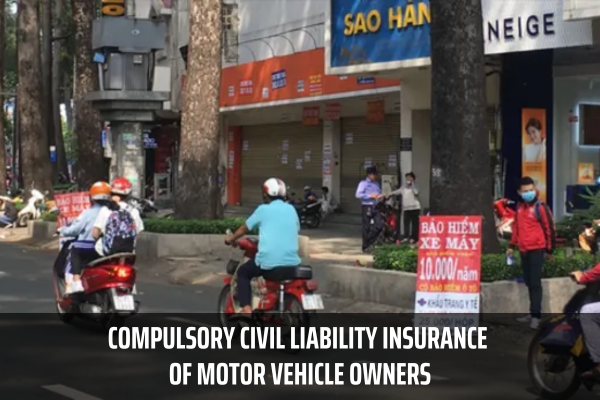If a motor vehicle owner loses his/her insurance certificate, what should he/she do? Does a certificate for compulsory civil liability insurance of motor vehicle owners in Vietnam include number plate?
- Does a certificate for compulsory civil liability insurance of motor vehicle owners in Vietnam include number plate?
- Vietnam: If a motor vehicle owner loses his/her insurance certificate, what should he/she do?
- What should a motor vehicle owner haing a insurance certificate do in case of an accident in Vietnam?
Does a certificate for compulsory civil liability insurance of motor vehicle owners in Vietnam include number plate?
Pursuant to Clause 2, Article 10 of Decree 67/2023/ND-CP on Insurance certificates:
Insurance certificates
...
2. Insurance certificates shall be designed by insurers. An insurance certificate shall include:
a) Name, address and phone number (if any) of motor vehicle owner.
b) Number plate and chassis number, engine number.
c) Type of vehicles, payload, seats, and use purposes (for automobiles).
d) Name, address and hotline number of insurer.
dd) Maximum coverage for the third party.
e) Responsibilities of motor vehicle owner, operator in case of accidents.
g) Insurance period, insurance premiums and payment deadlines of insurance premiums.
h) Date (day, month and year) of issue.
i) Number code and barcode registered, managed and used according to regulations of law to enable storage, transmission and extraction of ID information of insurer and ID information of compulsory civil liability insurance of motor vehicle owners.
...
Insurance certificates shall be designed by insurers. An insurance certificate shall include:
- Name, address and phone number (if any) of motor vehicle owner.
- Number plate and chassis number, engine number.
- Type of vehicles, payload, seats, and use purposes (for automobiles).
- Name, address and hotline number of insurer.
- Maximum coverage for the third party.
- Responsibilities of motor vehicle owner, operator in case of accidents.
- Insurance period, insurance premiums and payment deadlines of insurance premiums.
- Date (day, month and year) of issue.
- Number code and barcode registered, managed and used according to regulations of law to enable storage, transmission and extraction of ID information of insurer and ID information of compulsory civil liability insurance of motor vehicle owners.
Thus, number plate and chassis number, engine number must be included in a certificate for compulsory civil liability insurance of motor vehicle owners.

If a motor vehicle owner loses his/her insurance certificate, what should he/she do? Does a certificate for compulsory civil liability insurance of motor vehicle owners in Vietnam include number plate? (Image from the Internet)
Vietnam: If a motor vehicle owner loses his/her insurance certificate, what should he/she do?
Pursuant to Clause 1, Article 10 of Decree 67/2023/ND-CP on Insurance certificates:
Insurance certificates
1. When purchasing compulsory civil liability insurance of motor vehicle owners, motor vehicle owners shall be granted insurance certificates by insurers. Each motor vehicle shall be granted an insurance certificate. If a motor vehicle owner loses his/her insurance certificate, a written proposal concerning reissuance of insurance certificate submitted to the insurer is required.
...
Thus, If a motor vehicle owner loses his/her insurance certificate, a written proposal concerning reissuance of insurance certificate submitted to the insurer is required.
What should a motor vehicle owner haing a insurance certificate do in case of an accident in Vietnam?
Pursuant to Clause 1, Article 12 of Decree 67/2023/ND-CP on principles of indemnification:
Insurer shall consider and settle an insurance claim as prescribed by law on insurance business and the following principles:
- In case of an accident, the policyholder and the insured shall:
+ Immediately notify the insurer via hotline to cooperate in providing treatment in order to cure and limit damage to health, life and property, protect the accident scenes.
+ refrain from moving, dismantling or repairing property without consensus of insurers; except for cases in which such activities are necessary to ensure safety, prevent damage to health, life and property or comply with requests of competent agencies.
+ collect and provide documents required under an application for insurance claims within responsibilities of the policyholder and the insured for the insurer according to Article 13 of this Decree.
+ enable the insurer to verify documents provided by the policyholder and the insured.
- Within 1 hour after receiving notification of the accident, the insurer must inform the policyholder, the insured of safety measures to minimize damage to life and property, provide guidelines on the application and procedures for filing an insurance claim; closely cooperate with the policyholder, the insured, third party and relevant parties within 24 hours in organizing assessment of damage to determine causes and levels of damage which serve as the basis for settlement of the insurance claim.
- Within 3 working days after being notified by the policyholder or the insured about the accident, the insurer must provide advance indemnity for damage to health and life, to be specific:
In case the accident has been identified to be covered by insurance:
70% of estimated indemnity per person in case of fatalities.
50% of estimated indemnity per person in case of bodily injuries.
b) In case the accident has not been identified to be covered by insurance:
30% of the maximum coverage per person in case of fatalities and estimated whole person impairment (WPI) of 81% or more.
10% of the maximum coverage per person in case of estimated WPI of from 31% to less than 81%.
After providing advance indemnity, insurers may request MVIF to reimburse the advance payment if the accident is an insurance exclusion or not covered by insurance.
=> Therefore, in case of an accident, the policyholder and the insured shall:
(1) Immediately notify the insurer via hotline.
(2) refrain from moving, dismantling or repairing property without consensus of insurers, except for cases in which such activities are necessary
(3) collect and provide documents required under an application for insurance claims.
(4) enable the insurer to verify documents provided by the policyholder and the insured.
LawNet